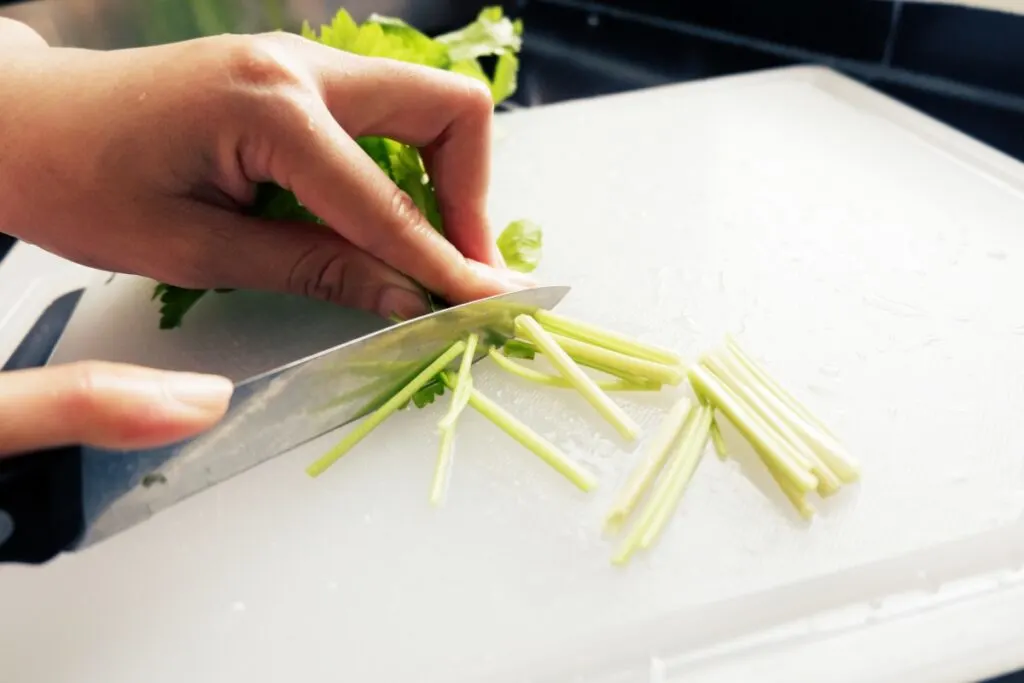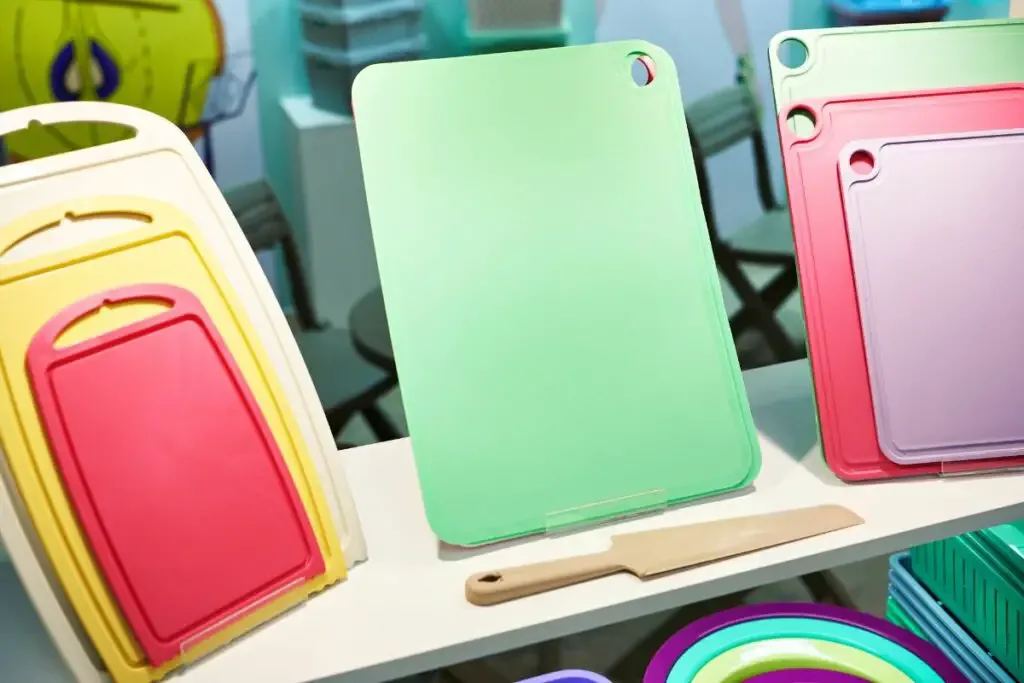As an Amazon Associate, we earn from qualifying purchases with no additional costs for you.
Cutting boards are a necessity in the kitchen to preserve your work surface, protect ingredients from contamination, and protect your knife’s cutting edge. There are various types of cutting boards available, including plastic cutting boards. How does plastic rate as a cutting board material, and will it damage your knives?
Plastic cutting boards can be bad for kitchen knives if the material is too hard, too soft, or too slippery. Most cheap plastic cutting boards are unsuitable for use with kitchen knives and will damage the cutting edge. High-end plastic cutting boards are formulated to be gentle on a knife’s edge.
Plastic is a modern material that is cheap to manufacture, and the cost savings are passed on to the buyer. While a plastic cutting board may save you a few dollars in the checkout line, it may be more expensive if you use it with your expensive kitchen knives!
If you are interested in checking out the best wooden cutting board, we recommend a cutting board made by the Virginia Boys Kitchens company. You can find it by clicking here (Amazon link).

Why Plastic Cutting Boards Are Bad For Knives
There are essentially four cutting board types that people buy. Some are good for using with your knives, while others will damage your knife edge, and the knife will become dull faster.
The four cutting board types are glass, stone or marble, plastic, and wood. Glass is extremely inflexible and rigid, and when used as a cutting board, it will rapidly dull your knife or even permanently damage the cutting edge.
Stone cutting boards are usually made from granite or marble. Using your knife on these cutting boards is the same as going outside and hitting the sharp edge of your knife on a rock. If you would never do this outside, why would you do it in your kitchen by using one of these cutting boards?
Plastic and wood are the only two cutting board types that are more acceptable for use in the kitchen. Wood is a traditional material used for hundreds of years as a cutting board and is known to do less damage to a knife edge.
Plastic is a modern, cheaper material, but using knives made from the wrong plastic can damage your knives. We will look at the top reasons why plastic cutting boards may not be the top choice for cutting board material.
1. Plastic Can Be Too Hard As A Cutting Board
Certain plastic compounds can be extremely hard and dense. These cutting boards will feel heavy in your hand due to the density of the plastic.
The surface will also be very hard, and it is this surface that will damage your knife’s sharp edge. When the sharp edge of a knife is pushed along the surface of a dense cutting board in a slicing motion, the hard plastic can cause the knife edge to round over, causing the blade to become dull.
The damage to the edge is even worse when the knife is used in a chopping action since the edge is repeatedly slammed against the hard surface.
The hard plastic will roll the edge on a Western kitchen knife, but the edge may chip or crack on a high-carbon steel Japanese kitchen knife. This could result in an expensive repair or irreparable damage to the knife.
2. Plastic Cutting boards Can Be Too Soft
On the other end of the scale, certain plastics can result in a cutting board surface that is too soft. A soft plastic compound will be more elastic, which will give the surface more flex than a hard plastic board.
This characteristic will result in less impact damage to the knife’s cutting edge when it is used on a softer plastic surface, but there are some problems if the surface is too soft.
When the plastic is too soft, the sharp edge of the knife easily scores the surface, causing cuts and gouges in the surface.
If the knife is used to slice through an ingredient and you slide it sideways across the board to move the sliced material out of the way, it can catch on the raised rough edges of the gouges. This can damage the knife’s edge.
If the knife slices down into the board and you twist your wrist, the knife edge can twist in the groove on the cutting board surface and cause the edge to become misaligned or snap the thin metal on the knife’s edge.
The grooves in the plastic can also harbor bacteria, making these soft plastic cutting boards unsanitary to use in the kitchen.
3. Plastic Cutting Boards Can Be Too Slippery
Plastic is a tough, durable material, but it can also be slippery when used as a cutting board. Kitchen work surfaces become wet in the normal course of food preparation, and this can become a problem when using plastic cutting boards.
Wet kitchen work surfaces can cause plastic cutting boards to slip when pressure is applied to your knife while cutting.
The knife can impact other objects on the countertop if the cutting board slips. If the knife tip impacts a hard surface, the blade could bend, which can snap the blade of a high-carbon steel knife.
The knife user also has a safety risk if a sharp kitchen knife slips and becomes unpredictable on a slippery cutting surface.
4. Plastic Cutting Boards Can Warp
Some people buy plastic cutting boards because they think they will be easier to maintain. Many people put their plastic cutting boards in the dishwasher with the other dirty dishes.
Thin plastic cutting boards and boards made from harder plastic can warp in the heat produced inside a dishwasher.
Warped boards will not sit flat on the kitchen work surface and will be dangerous to use with a sharp knife.
Are All Plastic Cutting Boards Bad For Knives?
Not all plastic cutting boards are bad for knives. Some knife manufacturers produce plastic cutting boards that are made from specially formulated plastic that has very similar properties to wood cutting boards.
These cutting boards are generally more expensive than the cheap plastic cutting boards from your local supermarket, but they won’t damage your expensive kitchen knives.
TIP: Any surface used in the kitchen for food preparation must be kept scrupulously clean. Find out the best methods for cleaning wood and bamboo cutting boards in the article below:
4 Proven Methods: Cleaning Wooden & Bamboo Cutting Boards
What Are the Best Cutting Boards To Use?

To help you to source good cutting boards that will cause less damage to your knives, we can recommend some quality cutting boards, including a plastic version.
Best: Virginia Boys Kitchens Walnut Wood Cutting Board
This wood cutting board is made from American Black Walnut and is an all-American made product. The wood is sourced from sustainably grown wood and is pre-seasoned with a coconut oil blend, making it suitable out of the packaging for use in the kitchen.
The Virginia Boys Kitchens Walnut Wood Cutting Board (Amazon link) is a long-grain cutting board, but the walnut wood is flexible enough to prevent damage on the knife’s cutting edge.
The cutting board has enough weight to keep it securely in place during use, and it will not warp, splinter, or crack if the board is regularly maintained.
Alternative: Yoshihiro Hi-Soft Cutting Board
Hayate Yoshihiro is a renowned Japanese kitchen knife manufacturer, so you can be sure that this plastic cutting board will be safe to use with any kitchen knife, including high-carbon steel knives.
The Yoshihiro Hi-Soft Cutting Board (Amazon link) is made from a specially formulated plastic intended to provide an ideal cutting surface for high-carbon steel blades.
The material is firm enough to be scratch-resistant but flexible enough to provide better edge retention on your kitchen knives.
Cheaper: Shun Cutlery Hinoki Cutting Board
Shun Cutlery is another manufacturer of quality kitchen knives, so you can trust that this cutting board is designed to be knife-friendly.
The Shun Cutlery Hinoki Cutting Board is made from Hinoki wood, a variety of Japanese cypress wood. The wood is naturally fragrant and fine-grained, making it ideal for a kitchen cutting board.
The wood fibers flex as you cut on the board, limiting pressure and resistance against the knife’s cutting edge.
Even though this cutting board is slightly cheaper than the other options, it is a quality product designed to protect your kitchen knives.
Environmental Impact of Plastic Cutting Boards

In today’s environmentally conscious world, understanding the impact of our kitchen choices on the planet is crucial. When it comes to cutting boards, the material not only affects the longevity and sharpness of our knives but also has a significant environmental footprint.
Let’s explore the environmental impact of plastic cutting boards compared to other materials, focusing on sustainability, lifespan, and disposal or recycling options.
Sustainability of Materials
Plastic cutting boards are often made from high-density polyethylene (HDPE) or polypropylene, both of which are derived from non-renewable fossil fuels. The production of these plastics involves significant energy consumption and greenhouse gas emissions.
In contrast, wooden cutting boards are made from a renewable resource. Woods like bamboo are particularly sustainable due to their rapid growth rate. However, it’s important to consider the source of the wood to ensure it is sustainably harvested.
Lifespan and Durability
The lifespan of a cutting board directly influences its environmental impact. Plastic cutting boards, while initially durable, can degrade and warp over time, especially when exposed to high temperatures in dishwashers.
This shorter lifespan means they may need to be replaced more frequently than their wooden counterparts. Wooden boards, if properly maintained, can last for decades, reducing the need for frequent replacement and, consequently, less waste.
Disposal and Recycling
End-of-life disposal is a critical aspect of a product’s environmental impact. Most plastic cutting boards are not biodegradable and can take hundreds of years to decompose in landfills.
While some types of plastic boards are recyclable, the recycling rates for plastics are generally low, and not all communities have the facilities to process them.
Wooden cutting boards are biodegradable and can be composted at the end of their life, making them a more eco-friendly option in terms of disposal.
Choosing a cutting board with a lower environmental impact is a small but significant step towards a more sustainable kitchen. While plastic cutting boards offer certain advantages, their environmental footprint is a crucial factor to consider.
Opting for sustainably sourced wooden cutting boards can be a more eco-friendly choice, benefiting both your knives and the planet. As consumers, being aware of these impacts allows us to make informed decisions that align with our environmental values.
Conclusion
Cutting boards are a kitchen essential, but the choice of material the cutting board is made from is important for the well-being of your kitchen knives.
Selecting the right cutting board will not only give you good service in the kitchen, but it will also improve the edge retention of your knives.
TIP: The choice of cutting board material is key, especially if you have expensive kitchen knives. Check out an in-depth guide on choosing the cutting board material in the article below:
3 Best Cutting Boards For Your Knives (Materials Compared)
